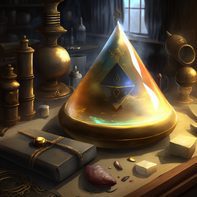Let’s just be clear. If the Philosopher’s Stone actually existed, turning lead into gold would only be a minor achievement.
Enough about the goals of Alchemy. Did the Philosophers stone actually exist?
“Philosophers stone” aka. “lapis philosophorum,” was believed to be a powerful magick artifact that could grant immortality.
It went by many names and it was known as the “Elixir of Life” or the “Red Stone.” In alchemy, the Philosopher’s Stone was considered to be the ultimate goal of the alchemical quest. It represented the attainment of spiritual enlightenment and the transmutation of the soul.
But did it exist? Well here is what I know….
Evidence of the Philosophers Stone
Did the Philosophers stone actually exist historically? The first idea of it comes from the annals of the Biblical narrative.
The Demiurge
The philosopher’s stone is said to have been one of three stones made by a character known as “the Demiurge”.

The demiurge was blamed for bringing about the deluge following a titanic struggle between good and evil. He was also said to be responsible for the creation of three magical artifacts:
- the Philosopher’s Stone
- the Crescent Moon Stone
- and the Celestial Angelic Stone
These stones were said to bestow the holder not only immortality but also the ability to grant wishes, and the ability to travel between dimensions.
At one point the demiurge controlled almost all of the world’s kingdoms. Eventually, though he would be vanquished in a climactic conflict that resulted in the unleashing of the deluge flood waters.
The myths of the demiurge and his stones of power have lasted throughout history, despite the fact that their meaning and significance may have altered through time.
The Mystery of Nicholas Flamel
Nicholas Flamel is a legendary and enigmatic historical figure.
It is believed that he lived in France in the 14th and 15th centuries. More significantly though, he is famed for allegedly discovering the Philosopher’s Stone. Flamel’s story has captivated people for ages, and his name has come to be associated with the search of alchemical knowledge and enlightenment.

Flamel’s life and achievements have sparked considerable discussion and speculation over the centuries. He was a scribe, bookseller, and manuscript copier who unearthed a secret book called the Book of Abraham the Jew, according to mythology. The book contained instructions for making the Philosopher’s Stone, a legendary material with the potential to turn base metals into gold and grant its possessor immortality.
Flamel was able to make the Philosopher’s Stone by following the directions in the book with the assistance of his wife, Perenelle. He used the stone to grow wealthy and to serve the needy, and his reputation as a skilled alchemist who had attained the ultimate aim of the alchemical quest developed over time.

Did the Philosopher’s Stone actually exist? and did Flamel have it?
Flamel became a legendary character in the realm of alchemy due to his supposed finding of the Philosopher’s Stone.
They believe that he had mastered Alchemy. Was he a master alchemist who had reached the pinnacle of the alchemical quest though? The only thing that makes one think so is that, over time, his name became associated with the Philosopher’s Stone and the pursuit of alchemical knowledge.
Notwithstanding the stories that surround Flamel, it is uncertain how much of his story is true. Many historians believe that Flamel’s reputation originated after his death and that he did not practice alchemy at all.His name and legacy, however, have remained intertwined with the history of alchemy and the pursuit of knowledge and enlightenment.
No matter what, I think he is still a fascinating and mysterious man, and his legacy as an alchemist and seeker of knowledge continues to inspire people today.
Accounts of the Real Philosophers Stone by “Asclepius”
“The Asclepius” is one of two philosophical books that are said to have been written by Hermes Trismegistus, an ancient Egyptian sage who was thought to have lived around the same time as Moses.
Asclepius was the all-around practice in the ancient magick of Hermeticism.

how to create the Philosophers stone
Asclepius wrote “The Book of Secrets,” which tells how the Philosopher’s Stone can be made. But it’s vague and written in the ancient wording of the alchemists and hermeticists:
- The sun and moon (gold and silver) must be dissolved in a special vinegar
- then mixed with quicksilver (mercury)
- heated over a low heat until a “ile” forms on top
The Philosopher’s Stone is said to be in this “ile.” But the vinegar used in the process is a dangerous mix of hydrochloric acid and sulfuric acid. This is known as “Aqua Regia” or “Royal Water.” Also, the book doesn’t say how to use the stone, which may have led to the deaths of many alchemists who tried to make it.
Later, some con artists said they could make the legendary stone. They convinced wealthy lords to give them money and nice places to live while they pretended to make the stone over many months or years. Others used tricks to trick investors, like melting down lead with gold is hidden underneath and claiming that the gold was the result of making the Philosopher’s Stone. Obviously, this process required expensive materials and took a long time to finish. Even though the Philosopher’s Stone is a well-known part of fantasy stories, just like unicorns, fairies, and wizards’ magic staffs, it doesn’t really exist.
Note: Another interesting read about Hermeticism is the Kybalion
Why do they keep calling it the Philosopher’s Stone?
So the reason that it’s called “Philosophers stone” goes back to a Latin Phrase “Lapis Philosophorum”. This term was mainly used in medieval alchemy though. It described the substance that would eventually come to be known as “The Philosopher’s stone.”
Philosophers stone is Arabic because Alchemy was originally from Arabic
The first time that the stone was referred to as “The philosophers stone” actually comes from ancient Middle East.
Zosimos of Panopolis, was a mystic in the Hermetic tradition. He is the first credited with coining the phrase “philosopher’s stone” in his book Cheirokmeta, which explores alchemy and metallurgy.
“Cheirokmeta” is derived from two Greek words: “cheir” (χείρ), meaning “hand”, and “kreas” (κρέας), meaning “meat” or “flesh”. Together, they roughly translate to “things made by hand” or “handicrafts”.
According to Zosimos, knowledge of these practices was obtained from fallen angels. Later translations of his work into Arabic introduced the term “Hajar Al-Falāsifa”, which became the focal point of alchemical research in the Arab Empire during the 8th to 14th centuries, known as the Golden Age of Islam.
These Arabic manuscripts would eventually get translated into Latin and Greek. This spurred on the new dawn of interest in everything alchemy. It spread all throughout Europe where the term “Lapis Philosophorum” became popular. The word “philosopher” derives from the Greek “philosophos”, meaning “lover of wisdom”.
Is the Philosopher’s Stone a metaphor?

In my personal opinion, yes.
The Philosopher’s Stone is a metaphor for the spiritually cleaned human soul, not a real thing. It depicts the ultimate version of oneself, attained via the use of spirit and water. Ultimately understanding specific hermetic symbols lead to transformation.
Obtaining the Philosopher’s Stone involves three major steps. The first stage, known as the dark stage, entails the soul’s severance from the body, which represents symbolic death. The white stage entails the union of the soul with the heavenly spirit. In the red stage, the soul is finally reunited with the resurrected body.
Note: Carl Jung had four stages of Alchemical Transformation in his writing.
The mechanics of this process vary. They are frequently veiled by layers of symbolism and metaphor. Alchemical methods involving chemicals such as mercury and sulfur are meant to represent it. The transmutation of base metals into gold was never intended to be literal! Rather it was meant as a metaphor for purifying anything until it achieves its greatest form. Search of the Philosopher’s Stone, in the end, is a quest for spiritual progress and enlightenment, leading to the realization of one’s ultimate potential.




